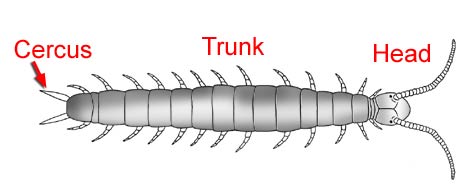- Symphyla

Common names: symphylans
Probability of encounter: medium
Quarantine importance: a few species are garden and glasshouse pests.
Similarity to mites: none other than small size. The distinct head with bead-like antennae and the trunk with many leg-bearing segments should distinguish symphylans from mites.
Body tagmata: head, trunk
Eyes: absent
Antennae: moniliform (bead-like), many segmented
Mouthparts: entognathous mandibles, maxillae, labium (fused 2nd maxillae)
Legs: 6-12 pairs
Respiration: tracheae, spiracles under antennae on head
Gonopore: venter of 4th trunk segment
Distinguishing features: myriapod form; distal trichobothria and spinneret cerci
Comments: Symphylans have a number of unique features including cranial tracheae, gonopore on trunk segment IV, and cerci used as spinnerets and flanked by well developed trichobothria. The legs have styli and eversible sacks associated with the coxae, as do diplurans.